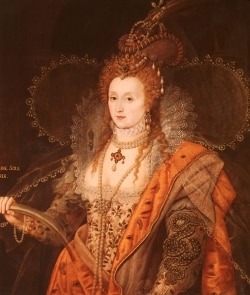
During the 44 years and 4 months of her reign as Queen of England, Elizabeth also had numerous other titles and was also associated with a rich symbolic language of allegorical and mythological-inspired metaphors. Let’s just take a quick look at some of these, and their significance:
Queen of England – Her official title, of course. She was crowned in Westminster Abbey on 15th January 1559. Later on, the people liked to call her ‘Good Queen Bess’ – an echo of her father’s nick name of ‘Good King Hal.’
Elizabeth R – This is how she often signed her documents. It is another way of showing herself in her official capacity – the ‘R’ representing the Latin word ‘Regina’ meaning ‘Queen.’
Supreme Head of the Church of England – This was inherited from her father, the first to bear that title (given him by the pope) and Elizabeth therefore became the first female monarch to exist not only without the constraints of a male consort, but also without the all-powerful Pope as the head of the Catholic Church. A unique position of independence.
Gloriana – This name was popularised in the epic poem by Edmund Spencer ‘The Faerie Queene’ published around 1590-96. It means the glorious light; the Sun; the light of the world – and in the complex allegorical language of renaissance culture, this astronomical body is always associated with royalty. It was perhaps this name that inspired the famous Rainbow Portrait of Elizabeth. Painted late in her reign, around the year 1600, it bears the inscription ‘NON SINE SOLE IRIS’ (No rainbow without the sun.) In mythology the rainbow is also a bridge, a link between the Gods and humanity – something for the perfect prince or ruler to have access to, therefore.

Virgin Queen – Though understood at an early stage, the unofficial title of ‘Virgin Queen’ became widespread as her reign progressed. Her coronation portrait shows her hair loose across her shoulders, indicating virginity. However, the term ‘virgin’ in Tudor times could be used in a general sense to describe ‘a maid,’ someone ‘un-wed.’ The term ‘virgo intacta’ was more applicable to a woman who had never had sexual intercourse. The word ‘Virgin’ was a little more open to interpretation.
Diana – The Greco/Roman mythologies provided a rich and fertile ground for those seeking allegorical titles for Elizabeth. The Goddess Diana (Artermis), with the Moon and the oceans as her dominion, is often depicted in iconography accompanied by a crescent moon, or with the long-bow (itself the shape of the crescent, virgin moon). The most salient feature about Artermis/Diana, however, was that she was the chaste virgin of the hunt. Elizabeth herself was an expert with the longbow, and a formidable horsewoman (though in her time, crossbows would have been the preferred weapon for the hunt).
Astraea – Another ancient Greek Goddess, Astraea is the celestial virgin, ‘the star-maiden’ and a figure associated with innocence and purity. It is another title that became poetically identified in late 16th century literature with the figure of the Queen. Astraea has her abode among the stars, particular those of the constellation Virgo, under which she was born, of course (7th September).
It is easy to forget the dreadful gulf that would have existed still in people’s minds following the removal during the Reformation of the Virgin Mary as an icon and figure of prayer. The brief return came in 1553 with the accession of Queen Mary, but it vanished again with Elizabeth, of course. To have a ‘virgin’ replacement in popular imagination was vital, therefore, to help her subjects undergo the painful psychological transition. The brilliant Elizabeth and her most trusted advisors understood this perfectly.
By Sarah Rochel



